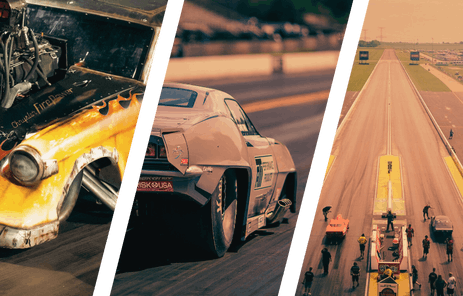It’s not something that those in the grandstands and lining the fence put a lot of thought to, but for competitors in the various forms of auto racing (including drag racing) out there, dealing with and managing sources of heat in their race cars is a front-and-center challenge each and every time they fire the car up or pull onto the track. Of course, other than brake rotors, exhaust, and the occasional turbocharger housing, you can’t exactly see heat, so it stands to reason why those on the sidelines can’t detect it, but those involved certainly can.
 In drag racing, in particular, racers are dealing with not only the typical engine, exhaust, and driveline heat, but they’re also putting signifiant temperature spikes into their tires during and following the burnout, and subsequently, onto the racing surface, in order to get the bit they need off the starting line. Add in bullhorn-style or zoomie headers and you’r dealing with quite the heat source.
In drag racing, in particular, racers are dealing with not only the typical engine, exhaust, and driveline heat, but they’re also putting signifiant temperature spikes into their tires during and following the burnout, and subsequently, onto the racing surface, in order to get the bit they need off the starting line. Add in bullhorn-style or zoomie headers and you’r dealing with quite the heat source.
But imagine if you could see heat.
Well, actually, you can, using some old military and law enforcement technology that’s become increasingly common in firefighting: infrared thermal imaging cameras.
Over in England, someone with access to a FLIR T620 camera, a $21,000 piece of equipment that looks much like your average, run-of-the-mill family camcorder, took it to the Santa Pod Raceway and stood along the race track, capturing some very cool footage that illustrates where and to what degree all of the heat is evident in, on, and around a race car at the track.
 The camera, which can detect temperatures ranging as high as 3,632 degrees Fahrenheit, picks up the heat built up within the fenders and hoods of race and street cars, as well as the exhaust trails both underneath the cars and shooting into the air from side- and hood-exit pipes. Of particular intrigue, though, is the heat the tires retain after the burnout, and the trails of heat the cars leave from the burnout box to the starting line, and from the starting line down the track. Certainly, we all know the tires are hot and that heat is being transferred to the racing surface (as intended to), but it’s a whole different thing to actually see it.
The camera, which can detect temperatures ranging as high as 3,632 degrees Fahrenheit, picks up the heat built up within the fenders and hoods of race and street cars, as well as the exhaust trails both underneath the cars and shooting into the air from side- and hood-exit pipes. Of particular intrigue, though, is the heat the tires retain after the burnout, and the trails of heat the cars leave from the burnout box to the starting line, and from the starting line down the track. Certainly, we all know the tires are hot and that heat is being transferred to the racing surface (as intended to), but it’s a whole different thing to actually see it.
In this one-of-a-kind clip, there’s also some footage of a jet dragster doing afterburner pops, which momentarily turn the rest of the scene back to a shade of cool blue in comparison to the heat being captured behind the dragster. This, not surprisingly, given the flame that’s probably approaching the temperature limitation of the camera.
Beyond what’s shown here, we’d love to see a close-up an engine running with the hood off, or an after-run time lapse of the tires cooling down as the car rolls through the shutdown area and the exhaust and other components cooling from scorching-hot back to ambient. Or, perhaps even a clip from the starting line following the unique heat trails left behind by a nitro car, and the path of the slicks, which undoubtedly leave heat tracks all the way down the 1,000-feet strip.
You might also like
SEMA 2025: Paul Rossi Unveils New Gen 3 HEMI-Powered Super Stocker
Paul Rossi has a new high tech Super Stocker coming to the track. PMR Race Cars and Blackbird Performance have backed this amazing build.


